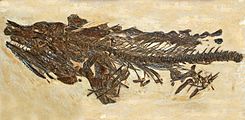Cimolichthys
| Cimolichthys Temporal range: | |
|---|---|

| |
| C. nepaholica mount, University of Michigan Museum of Natural History | |
| Scientific classification | |
| Domain: | Eukaryota |
| Kingdom: | Animalia |
| Phylum: | Chordata |
| Class: | Actinopterygii |
| Order: | Aulopiformes |
| Superfamily: | †Cimolichthyoidea |
| Family: | †Cimolichthyidae Goody, 1969 |
| Genus: | †Cimolichthys Leidy, 1857 |
| Type species | |
| †Cimolichthys levesiensis Leidy, 1857 | |
| Species | |
| |
| Synonyms | |
| |
Cimolichthys (Greek for "chalk fish") is an extinct genus of large predatory marine aulopiform ray-finned fish known worldwide from the Late Cretaceous. It is the only member of the family Cimolichthyidae.[2][3]
Taxonomy

Cimolichthys was a large-sized nektonic aulopiform fish, making it related to modern lancetfish and lizardfish. Within the Aulopiformes, it is generally considered a member of the Enchodontoidei, a dominant group of predatory nektonic fish throughout much of the Cretaceous;[3][4] however, some other treatments instead place it outside the Enchodontoidei and in a basal position as sister to the waryfishes, a small family of extant deep-sea aulopiformes.[5] Yet other studies have instead placed it as a sister to the extant daggertooths.[6]
The following species are known:[7]
- †C. levesiensis Leidy, 1857 - Cenomanian of England (English Chalk),[8] late Cenomanian/early Turonian of Germany (Hesseltal Formation),[9] possibly Turonian of Canada (Kaskapau Formation)[10]
- †C. nepaholica Cope, 1872 - Turonian to Campanian of Canada (Vermilion River Formation of Manitoba, Northwest Territories), Cenomanian to Maastrichtian of the United States (Mooreville Chalk of Alabama, Greenhorn Limestone of Colorado, Niobrara Formation of Kansas & South Dakota), and Maastrichtian of the Netherlands & Belgium (both Maastricht Formation)[11]
C. anceps, C. gladiolus, C. semianceps, C. contracta, C. merillii, and C. sulcatus, all described by Cope (1872), are now considered synonymous with C. nepaholica.[3][12] Indeterminate remains are known from the Maastrichtian of Niger & Brazil, and the Turonian of the Czech Republic.[7][13]
Description
Although the closest living relatives of Cimolichthys are lancetfish and lizardfish, the living animals would have resembled very large pikes. They could grow up to 1.5 to 2.0 metres (4.9 to 6.6 ft) meters long. Their bodies were covered by large, heavy scutes. Typical of this species are narrow lower jaws with several series of teeth. Remains of undigested fishes or squids have been found in collected specimens. Particularly well-preserved specimens are known from the Niobrara Formation of Kansas.[14] Their barbed teeth are distinctive, and can identify the presence of this genus even in formations where articulated remains are not otherwise known.[11]
Gallery
- Cimolichthys at the Canadian Museum of Nature, Ottawa
- Restoration of Cimolichthys nepaholica.
References
- ^ Paleobiology Database
- ^ "PBDB Taxon". Paleobiology Database. Retrieved 2024-05-17.
- ^ a b c Silva, Hilda M. A; Gallo, Valéria (June 2011). "Taxonomic review and phylogenetic analysis of Enchodontoidei (Teleostei: Aulopiformes)". Anais da Academia Brasileira de Ciências. 83 (2): 483–511. doi:10.1590/S0001-37652011000200010. PMID 21670874.
- ^ Davis, Matthew P.; Fielitz, Christopher (2010). "Estimating divergence times of lizardfishes and their allies (Euteleostei: Aulopiformes) and the timing of deep-sea adaptations". Molecular Phylogenetics and Evolution. 57 (3): 1194–1208. Bibcode:2010MolPE..57.1194D. doi:10.1016/j.ympev.2010.09.003. ISSN 1055-7903.
- ^ Near, Thomas J.; Thacker, Christine E. (2024). "Phylogenetic Classification of Living and Fossil Ray-Finned Fishes (Actinopterygii)". Bulletin of the Peabody Museum of Natural History. 65 (1): 3–302. doi:10.3374/014.065.0101. ISSN 0079-032X.
- ^ Díaz-Cruz, Jesús Alberto; Giles, Sam; Hermione T Beckett; Alvarado-Ortega, Jesus (2020). "A redescription of Cimolichthys lewesiensis leidy, 1857 (Aulopiformes: Cimolichthyidae) based on computed tomography with comments on its phylogenetic position". Fishes & Chondrichthyans: Evolution & Distribution. doi:10.13140/RG.2.2.24324.76161.
- ^ a b "PBDB Taxon". Paleobiology Database. Retrieved 2024-05-17.
- ^ Friedman, Matt; Beckett, Hermione T.; Close, Roger A.; Johanson, Zerina (2016). "The English Chalk and London Clay: two remarkable British bony fish Lagerstätten". Geological Society, London, Special Publications. 430 (1): 165–200. Bibcode:2016GSLSP.430..165F. doi:10.1144/SP430.18. ISSN 0305-8719.
- ^ Hunt, Adrian P.; Milàn, Jesper; Lucas, Spencer G.; Spielmann, Justin A. (2012). Vertebrate Coprolites: Bulletin 57. New Mexico Museum of Natural History and Science.
- ^ Wilson, Mark V. H.; Chalifa, Yael (1989-12-01). "Fossil marine actinopterygian fishes from the Kaskapau Formation (Upper Cretaceous: Turonian) near Watino, Alberta". Canadian Journal of Earth Sciences (in French). 26 (12): 2604–2620. Bibcode:1989CaJES..26.2604W. doi:10.1139/e89-222. ISSN 0008-4077.
- ^ a b Friedman, M. (2012-01-01). "Ray-finned fishes (Osteichthyes, Actinopterygii) from the type Maastrichtian, the Netherlands and Belgium". Scripta Geologica. Special Issue. 08: 113–142. ISSN 0922-4564.
- ^ Beirut, American University of; Day, Alfrid; Hay, Oliver Perry. "On a collection of Upper Cretaceous fishes from Mount Lebanon, Syria, with descriptions of four new genera and nineteen new species. Bulletin of the AMNH ; v. 19, article 10". Biodiversity Heritage Library. Retrieved 2024-05-17.
- ^ Ekrt, Boris; Košt'ák, Martin; Mazuch, Martin; Voigt, Silke; Wiese, Frank (2008-08-01). "New records of teleosts from the Late Turonian (Late Cretaceous) of the Bohemian Cretaceous Basin (Czech Republic)". Cretaceous Research. 29 (4): 659–673. Bibcode:2008CrRes..29..659E. doi:10.1016/j.cretres.2008.01.013. ISSN 0195-6671.
- ^ "Cimolichthys". oceansofkansas.com. Retrieved 2024-05-17.
- Sepkoski, Jack Sepkoski's Online Genus Database


